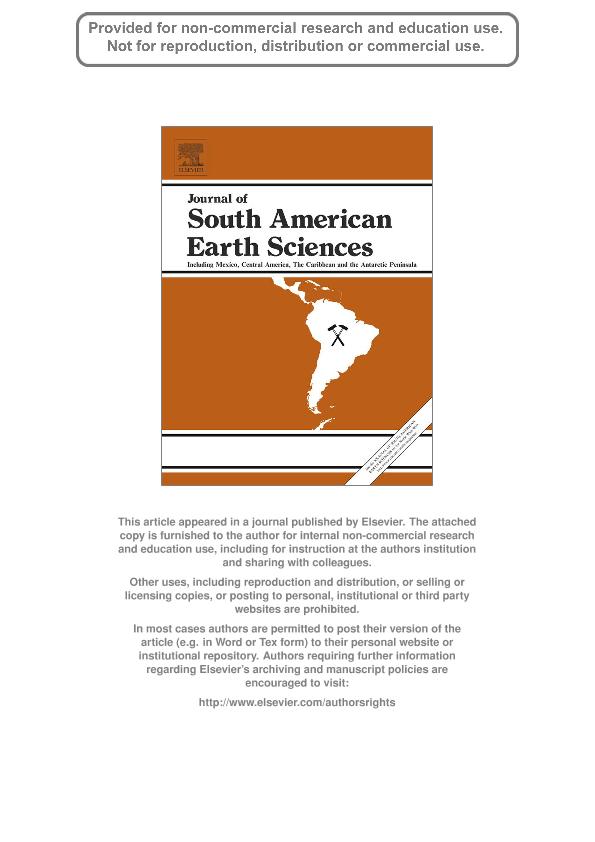Artículo
The Aguilar pluton (23°12′ S–65°40′ W; NW Argentina): Petrological implications on the origin of the Late Jurassic intraplate magmatism in the Central Andes
Omarini, Ricardo Hector ; Gioncada, Anna; Vezzoli, Luigina; Mazzuoli, Roberto; Cristiani, Chiara; Sureda, Ricardo Jose
; Gioncada, Anna; Vezzoli, Luigina; Mazzuoli, Roberto; Cristiani, Chiara; Sureda, Ricardo Jose
 ; Gioncada, Anna; Vezzoli, Luigina; Mazzuoli, Roberto; Cristiani, Chiara; Sureda, Ricardo Jose
; Gioncada, Anna; Vezzoli, Luigina; Mazzuoli, Roberto; Cristiani, Chiara; Sureda, Ricardo Jose
Fecha de publicación:
07/2013
Editorial:
Elsevier
Revista:
Journal of South American Earth Sciences
ISSN:
0895-9811
Idioma:
Inglés
Tipo de recurso:
Artículo publicado
Resumen
The Late Jurassic Aguilar pluton is located in NW Argentina, about 300–400 Km east of the Tarapacá basin, representing the backarc basin linked to the Jurassic volcanic arc. This small-size and compositionally heterogeneous pluton intruded the metasedimentary rocks of the Ordovician Santa Victoria Group, along the Cobres-Salinas Grandes lineament. A revision of published geochemical data in the light of new field and petrological results, allows us to propose a model concerning the petrogenesis and emplacement mechanisms of Aguilar pluton and to discuss its geodynamic setting. The pluton is mainly composed of metaluminous and nearly peraluminous granitoids, showing the geochemical characteristics of ferroan granites. The volumetrically subordinate mafic rocks are both ne- and hy-normative, and their primary magmas were generated by partial melting of a pristine Proterozoic mantle. Aguilar rocks display a rather limited range in (87Sr/86Sr)i, compared to the entire rift-related plutonic suite, i.e., 0.703198–0.704601, and εNdt from −1.06 to 3.82, calculated at 149 Ma. Fractional crystallization of mantle-derived magmas and crustal contamination processes explain the evolution to produce strongly silica-oversaturated magmas, which emplaced in the continental crust. The petrological data indicate that magma emplacement and cooling occurred at rather shallow depth. Multiple injections of magma batches into the magma chamber caused mingling and mixing processes early in the crystallization history. The Aguilar pluton is one of the several igneous complexes whose formation was associated with the extensional tectonics active during Late Jurassic-Early Cretaceous in NW Argentina. Based on the geological position and the igneous rocks affinity, we exclude that the Late Jurassic magmatism was generated in an orogenic setting and envisage that it was linked to the early extensional phase that preceded the Cretaceous continental rifting, related to the break–up of the South America-Africa continents.
Palabras clave:
Ferroan Granitoid
,
Intraplate Magmatism
,
Jurassic
,
Nw Argentina
,
Central Andes
Archivos asociados
Licencia
Identificadores
Colecciones
Articulos(CCT - SALTA-JUJUY)
Articulos de CTRO.CIENTIFICO TECNOL.CONICET - SALTA-JUJUY
Articulos de CTRO.CIENTIFICO TECNOL.CONICET - SALTA-JUJUY
Citación
Omarini, Ricardo Hector; Gioncada, Anna; Vezzoli, Luigina; Mazzuoli, Roberto; Cristiani, Chiara; et al.; The Aguilar pluton (23°12′ S–65°40′ W; NW Argentina): Petrological implications on the origin of the Late Jurassic intraplate magmatism in the Central Andes; Elsevier; Journal of South American Earth Sciences; 47; 7-2013; 55-71
Compartir
Altmétricas



